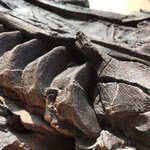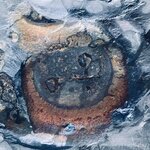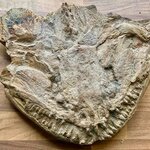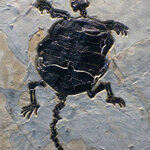Paleontology

This fellow is the graptolite, Isograptus cf. maximus, from the Piranha Formation, Middle Ordovician (Dapingian), Bolivia.
Graptolites (Graptolita) are colonial animals. The biological affinities of the graptolites have always been debatable. Originally regarded as being related to the hydrozoans, graptolites are now considered to be related to the pterobranchs, a rare group of modern marine animals. They are hemichordates, phylum Hemichordata, a primitive group who share a common ancestry with the vertebrates. Yes, you're looking at one of your oldest relatives!
In life, many graptolites…

This well-preserved partial ichthyosaur was found in the Blue Lias shales by Lewis Winchester-Ellis. The vertebrae you see are from the tail section of this marine reptile. The find includes stomach contents which tell us a little about how this particular fellow liked to dine. As with most of his brethren, he enjoyed fish and cephalopods. Lewis found fish bone and squid tentacle hooklets in his belly. Oh yes, these ancient cephies had grasping hooklets on their tentacles. I'm picturing them wiggling all ominously. The hooklets were the only hard parts of the animal preserved in…

This fellow is Chengjiangocaris kunmingensis, a rather glorious fuxinhuiid arthropod. While he looks like he could be from the inside of the Lascaux Caves and their fire-kissed Palaeolithic paintings, albeit by a very ancient Picasso, he was found at a UNESCO World Heritage Cambrian fossil site in southern China.
As his name indicates, he is from a locality in the Yunnan region near Kunming. He is unusual in many ways, both because of the remarkable level of preservation and the position in which he was found. This fellow proved to be a rather fortunate specimen as his carapace had…

Move over Burgess, there's a new Cambrian Lagerstätten in town. Meet Tuzoia sinesis from the Balang Formation of southern China. China has some very interesting fossil specimens being unearthed that challenge the Burgess Shale for preservation and variety of fauna. This large extinct bivalved arthropod, Tuzoia sinesis (Pan, 1957) is from one of those sites.
The specimen was found in Cambrian deposits of the Balang Formation. The Balang outcrops in beautiful Paiwu, northwestern Hunan Province in southern China. The site is intermediate in age between the Lower Cambrian…

Salmon have permeated First Nations mythology and have been prized as an important food source for thousands of years.
For the Salish people of the Interior of British Columbia, Canada, salmon was the most important of the local fishing stock and salmon fishing season was a significant social event which warranted the nomination of a “Salmon Chief” who directed the construction of the hooks, weirs and traps and the distribution of the catch.
In the Interior of the province, archaeological evidence dates the use of salmon as a food source back 3,500 years. Sheri Burton and Catherine…

This well-preserved fossil fish skull is from Calamopleurus (Agassiz, 1841), an extinct genus of bony fishes related to the heavily armored ray-finned gars. They are fossil relics, the sole surviving species of the order Amiiformes. Although bowfins are highly evolved, they are often referred to as primitive fishes and living fossils as they retain many of the morphologic characteristics of their ancestors.
This specimen of Calamopleurus cylindricus was collected in Lower Cretaceous outcrops of the Santana Formation in the Araripe Basin UNESCO Global Geopark of northeastern Brazil.

Plesiosaurus were large, carnivorous air-breathing marine reptiles with strong jaws and sharp teeth that moved through the water with four flippers. We'd originally thought that this might not be the most aerodynamic design but it was clearly effective as they used the extra set to create a wee vortex that aided in their propulsion. In terms of mechanical design, they have a little something in common with dragonflies.
We've recreated plesiosaur movements and discovered that they were able to optimize propulsion to make use of their own wake. As their front flippers paddled in big circular…

Mammoths were herbivore grazers native to Africa, Europe, Asia and North America. They lived out their long lives, 60-80 years, on the mammoth steppe, a periglacial landscape with lush grass vegetation. Mammoths used their well-designed teeth to graze on grasses, leaves, trees, shrubs and moss. Theirs was not a pretty end. Mammoths from this isolated population on Wrangell Island lost the genetic lottery with DNA mutations so abundant that they eventually led to their extinction.
In a paper published in PLOS, Rebekah Rogers describes that last populations of these once mighty beasts, "The…

An Eocene Cryptodiran Fossil Turtle, Baena arenosa, reveals the design of the last of his lineage in finds from fine-grained lime mud outcrops in the Green River Formation, Wyoming, USA.
The Baena's with their extra long tails marks the last of their lineage as the extinct family Baenidae appeared first in the Jurassic and died out at the end of the Eocene. We've found specimens of Baena, along with 14 other species of turtles in seven genera and five families in the lower Eocene San Jose Formation, San Juan Basin of New Mexico.
This specimen is from the Green River Formation of Wyoming…

Cows and chickens will never go extinct because they are food, and some useless critters like Aedes aegypti have managed to tough it all despite being just disease vectors. For everything else, it can be a crap shoot. Nature is out to kill us all.
Like the dodo. We don't really know a lot about the dodo, but almost everyone has heard of it, because it went extinct a few hundred years ago, one of those rare cases where a species was at least known before it was wiped out. All we have is inference and speculation based on vague accounts and hand-drawn pictures, starting with Dutch sailors who…